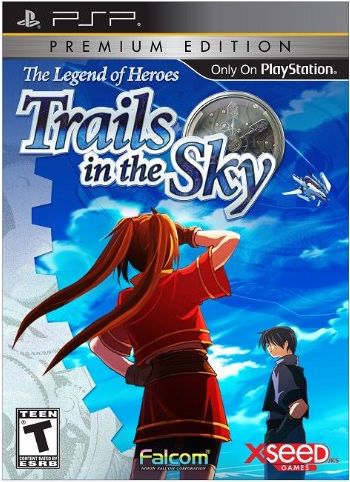After a heyday spanning the Playstation and Playstation 2 eras, Japanese RPGs (at least, those translated into English) have retreated from home consoles: the Playstation 3 offers nowhere near the riches that its predecessors did. To some extent, portable consoles such as the PSP have picked up the slack with excellent tactical RPGs such as Tactics Ogre and Final Fantasy Tactics, as well as pure JRPGs such as Persona 3: Portable. How does another contestant in the PSP camp, pure RPG The Legend of Heroes: Trails in the Sky (Falcom 2006, released in the US by Xseed in 2011), measure up?
The answer is, “It’s a trick question.” From its roots up, I found Trails to be a very different beast to many other RPGs, including those I named above. This is not because it’s groundbreaking. It’s not: the story is linear and combat is turn/party/menu-based. Rather, where other games are built to challenge – for example, P3:P offers challenging gameplay, while FFT and Tactics Ogre also challenge the genre’s storytelling conventions – Trails seems built for relaxation.
For example, Trails’ story and characters are a mishmash of familiar archetypes. Its young heroes – a cheerful hothead and her calmer brother – rove the land Fighting Evil and Righting Wrongs. The plot twists are guessable, the other party members out of central casting. But it works. The heroes are likeable, and their dialogue often witty – witty enough to make me laugh out loud a couple of times. The villains are dastardly, but never disturbing. The music is cheery, the towns and landscapes detailed. The net effect: a mood that’s nice and pleasant, and a world conducive to wandering around and seeing the sights.
(A quick story aside: Trails is the first game in a trilogy, and also the only one, so far, to be officially released in English. However, its plot mostly stands alone – there is a sequel hook, but it feels like the first act of a new story rather than a loose end. As such, this shouldn’t be an obstacle for potential buyers.)
Trails’ gameplay produces a similar effect. For starters, it avoids the single most annoying genre convention: random battles. Instead, you can dodge monsters a la Chrono Trigger and Persona, which saves a lot of aggravation. And there’s precious little need to grind – I did almost every sidequest in the game and that was plenty. Character management is reasonably complex: I had to put some thought into juggling different party members’ specialties, and mixing and matching the “orbments” that determine available magic spells. But I found the actual battles pretty easy: most enemies, and even most bosses, just didn’t hit hard enough to be dangerous. True, combat needed some mental involvement – I couldn’t just mash X to attack. But once I equipped a sensible choice of orbments, I’d just bring out the appropriate elemental spells, then heal as needed. The outcome was rarely in doubt: I could count on the fingers of one hand all the times I Game Overed. (Even when I did, no big deal; you can instantly replay a lost battle, and the game allows saving anywhere.) No hair-tearing moments here, just an agreeable way to while away time.
And that is how I’d sum up my Trails experience: “an agreeable way to while away time”. If you’re not already a JRPG fan, I don’t think this will bring you on board – it adds nothing radically new to the recipe. But if you do enjoy JRPGs, Trails is like comfort food: low-stress and easygoing. For genre buffs in the mood for old-fashioned home cooking, Trails might just be worth a look.
I hope you enjoyed this post! To quickly find this post, and my other reviews, click the “reviews” tab at the top of this page.
Resources
The basis of my review
Length of time spent with the game: ~50 hours.
What I have played: Finished the game.
What I haven’t played: n/a
